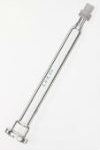Frequently Asked Questions
Check out some of the most frequently asked questions below.
Calibrated buret replacement at defined intervals is required to keep your titration system operating at peak performance, so your work stays accurate and your lab remains efficient.
Over time, the glass buret of your titrator is subject to normal wear through chemical corrosion, mechanical abrasion, and aging. Each case has a negative impact on buret integrity and dosing accuracy which leads to unplanned downtime and loss of confidence in your data.
Calibration frequency depends on your application and usage. In general, Metrohm recommends calibrated buret replacement every:
- 3 months for alcoholic or concentrated alkaline solutions
- 6 months for aqueous non-concentrated alkaline solutions
- 12 months for all other titrants
To minimize the risk of inaccurate dosing and meet compliance requirements, Metrohm also recommends on-site system certification and preventative maintenance of the associated titrator, dosing drive, and autosampler every 12 months. This annual on-site service includes calibrated buret replacement by a factory-certified service engineer.
Calibrated burets are considered a consumable and can be purchased directly through the Metrohm USA Webshop. Not sure what calibration frequency is best for your lab? We can help! Contact our technical support team at 866-638-7646.
On-site certification and preventative maintenance of your analytical system includes calibrated buret replacement and should be performed by Metrohm USA at 12-month (minimum) intervals. To request service please contact our service specialist team at 1-866-783-0546 or complete the Online Service Request Form.
If you are using alcoholic or concentrated alkaline solutions, you should replace the buret every 3 months. For aqueous non-concentrated alkaline solutions, you should replace the buret in 6-month intervals.
Calibrated burets are considered a consumable and can be purchased directly through the Metrohm USA Webshop using the below part numbers.
| Cylinder Volume | Dosing Unit |
Exchange Unit |
|---|---|---|
| 1 mL | Not available | CAL-61518113 |
| 2 mL | CAL-61574120 | Not available |
| 5 mL | CAL-61574150 | CAL-61518150 |
| 10 mL | CAL-61574210 | CAL-61518210 |
| 20 mL | CAL-61574220 | CAL-61518220 |
| 50 mL | CAL-61574250 | CAL-61518250 |
The cylinder and piston are calibrated as a pair and cannot be calibrated individually.
When selecting a calibration service provider, it is important to understand how the relevant quality standards impact compliance in your lab. Many calibration providers meet the requirements of ISO 17025; however, few meet the requirements of ISO 8655-3.
While both standards reference International Organization for Standardization (ISO), each define separate aspects of quality required for accurate and reliable dosing. Metrohm USA meets the requirements for both ISO 17025 and ISO 8655-3.
ISO 17025
ISO 17025 accreditation helps you minimize risk by ensuring you are choosing a technically competent lab that has a strict quality system in place. To achieve ISO 17025 accreditation, a laboratory must demonstrate they are technically proficient and able to produce precise and accurate calibration data accounting for system and random uncertainties. This includes regular re-assessment by a certified accreditation body of quality procedures, staff competency, traceability of measurements, maintenance of test equipment, validity of test methods, and quality of testing environment.
ISO 8655: Designed to resemble everyday titrations, the ISO 8655-3 method is the globally accepted gravimetric test used by Metrohm USA’s calibration lab. ISO 8655 is the most critical ISO standard for calibrating piston operated burets, outlining the required method, test conditions and equipment, reporting requirements and required measurement uncertainty values.
During the gravimetric test, dispensed water is weighed and the volume dosed is calculated using the specific density of water. As specified in the standard ISO 8655-3:Piston-Operated Volumetric Apparatus, ten individual measurements are performed at three volumes across the buret range: 10%. 50% and 100% of the nominal buret volume. Error limits are clearly defined in ISO 8655:2002 for the maximum permissible systematic error and the maximum permissible random error for a buret at specific volumes. The systematic and the random measurement errors are calculated from the measured values.
To be considered valid by ISO 8655-3, measurements must occur in a strictly controlled test environment. In accordance with ISO requirements, our calibration lab provides a controlled test environment monitoring air and water temperature, relative humidity, and barometric pressure.
Our calibration lab is equipped with a dedicated HVAC system and 24/7 monitoring and recording with measurements taken every 15 seconds.
- Temperature: Verifies < 0.5 degree C variance over the course of the calibration test duration
- Humidity: Verifies > 50% constant relative humidity
- Barometric Pressure: Recorded for mass calculations
We use clean, pure water conforming with grade 3 as specified in ISO 3696 in accordance with ISO 8655-3.
Yes! Controlled by Tiamo software, calibrations are setup by a Factory Certified Service Engineer and performed automatically following a protected procedure. Tiamo software is fully 21 CFR Part 11 compliant.
You can easily download your certificate here. All you need is the model and serial number of your buret.
Have additional questions? Contact our service specialist team at 866-638-7646.

